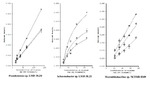Chemolithoheterotrophy: Means to Higher Growth Yields from this Widespread Metabolic Trait
| dc.contributor.author | Boden, Rich | |
| dc.contributor.author | Hutt, LP | |
| dc.contributor.editor | Rojo F | |
| dc.date.accessioned | 2018-07-24T16:22:37Z | |
| dc.date.available | 2018-07-24T16:22:37Z | |
| dc.date.issued | 2018-04-16 | |
| dc.identifier.isbn | 978-3-319-39782-5 | |
| dc.identifier.uri | http://hdl.handle.net/10026.1/11881 | |
| dc.description.abstract |
Chemolithoheterotrophy is a mixed metabolic mode in which heterotrophic growth is augmented by energy conserved from the oxidation of an inorganic electron donor such as thiosulfate or sulfide (or from sulfide moieties in methylated sulfur species). This results in an increased specific molar growth yield and a more efficient uptake of carbon from the carbon source, which can lead to more efficient biomass or product formation or more efficient degradation of pollutants etc. In this chapter we discuss the potential for harnessing this metabolic trait in biotechnology with critical evaluation of studies thus far. | |
| dc.format.extent | 32 | |
| dc.format.extent | 1-25 | |
| dc.language.iso | en | |
| dc.publisher | Springer | |
| dc.relation.ispartof | Aerobic Utilization of Hydrocarbons, Oils and Lipids. Handbook of Hydrocarbon and Lipid Microbiology. | |
| dc.rights | Attribution-NoDerivatives 4.0 International | |
| dc.rights | Attribution-NoDerivatives 4.0 International | |
| dc.rights | Attribution-NoDerivatives 4.0 International | |
| dc.rights | Attribution-NoDerivatives 4.0 International | |
| dc.rights | Attribution-NoDerivatives 4.0 International | |
| dc.rights | Attribution-NoDerivatives 4.0 International | |
| dc.rights | Attribution-NoDerivatives 4.0 International | |
| dc.rights.uri | http://creativecommons.org/licenses/by-nd/4.0/ | |
| dc.rights.uri | http://creativecommons.org/licenses/by-nd/4.0/ | |
| dc.rights.uri | http://creativecommons.org/licenses/by-nd/4.0/ | |
| dc.rights.uri | http://creativecommons.org/licenses/by-nd/4.0/ | |
| dc.rights.uri | http://creativecommons.org/licenses/by-nd/4.0/ | |
| dc.rights.uri | http://creativecommons.org/licenses/by-nd/4.0/ | |
| dc.rights.uri | http://creativecommons.org/licenses/by-nd/4.0/ | |
| dc.subject | Chemolithoheterotrophy | |
| dc.subject | Sulfur metabolism | |
| dc.subject | Polythionates | |
| dc.subject | Energy conservation | |
| dc.subject | Bioenergetics | |
| dc.title | Chemolithoheterotrophy: Means to Higher Growth Yields from this Widespread Metabolic Trait | |
| dc.type | chapter | |
| plymouth.edition | 2018 | |
| plymouth.volume | Aerobic Utilization of Hydrocarbons, Oils and Lipids. | |
| plymouth.publisher-url | http://www.springer.com/ | |
| plymouth.publication-status | Published | |
| plymouth.series | Handbook of Hydrocarbon and Lipid Metabolism | |
| dc.identifier.doi | 10.1007/978-3-319-39782-5_51-1 | |
| plymouth.organisational-group | /Plymouth | |
| plymouth.organisational-group | /Plymouth/Faculty of Health | |
| plymouth.organisational-group | /Plymouth/Faculty of Health/School of Biomedical Sciences | |
| plymouth.organisational-group | /Plymouth/Faculty of Science and Engineering | |
| plymouth.organisational-group | /Plymouth/Faculty of Science and Engineering/School of Biological and Marine Sciences | |
| plymouth.organisational-group | /Plymouth/REF 2021 Researchers by UoA | |
| plymouth.organisational-group | /Plymouth/REF 2021 Researchers by UoA/UoA01 Clinical Medicine | |
| plymouth.organisational-group | /Plymouth/REF 2021 Researchers by UoA/UoA06 Agriculture, Veterinary and Food Science | |
| plymouth.organisational-group | /Plymouth/Users by role | |
| plymouth.organisational-group | /Plymouth/Users by role/Academics | |
| dc.publisher.place | Cham, Switzerland | |
| dc.rights.embargoperiod | Not known | |
| rioxxterms.funder | Royal Society | |
| rioxxterms.identifier.project | Chemolithoheterotrophy, a poorly understood metabolic trait | |
| rioxxterms.version | Accepted Manuscript | |
| rioxxterms.versionofrecord | 10.1007/978-3-319-39782-5_51-1 | |
| rioxxterms.licenseref.uri | http://creativecommons.org/licenses/by-nd/4.0/ | |
| rioxxterms.type | Book chapter | |
| plymouth.funder | Chemolithoheterotrophy, a poorly understood metabolic trait::Royal Society |




